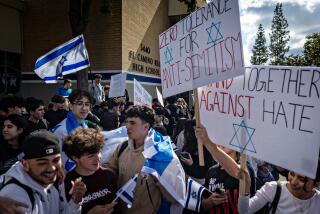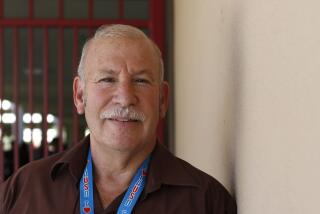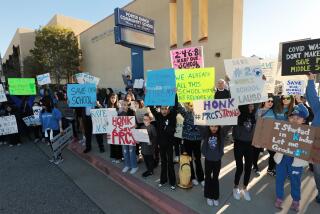L.A. Unified commemorates 50th anniversary of Eastside walkouts, but tells students to stay in class March 14
Fifty years ago, Mexican American students in East L.A. high schools walked out of class and launched a historic movement protesting substandard conditions in their schools.
Garfield High School, where the walkouts began March 5, 1968, commemorated that movement Thursday by ceding the stage to its current students. One group performed a musical history of the so-called blowouts: “We’ve got to walk out, walk out for justice. We’ve got to walk out, walk out for brown rights.” A young man recited a poem he had written about what it means to be Chicano in East L.A. today.
In 1968, students were trying to call attention to a host of problems in their schools, including massive class sizes, racist teachers and the use of corporal punishment, said Yoli Rios, who walked out of Lincoln High School half a century ago. She told hundreds of Garfield students gathered for a special assembly that her math teacher would put an assignment on the board, then pull out a putter and and practice his golf.
The walkouts brought almost immediate changes, Bobby Verdugo, Rios’ husband and a fellow walkout leader, said in an interview. Corporal punishment disappeared. Chicano college-going rates increased. But both Rios and Verdugo pointed out that students still face hurdles today. Black and Latino students still are often tracked into less academically challenging classes. Class sizes remain large. Schools in wealthier communities still have greater resources.
Valeria Salazar Gamboa, 16, delivered a speech calling out the inequalities that she said still exist at Garfield. High-achieving students get the recognition and resources, she said, and the district’s supposedly random searches often feel targeted and foster an environment of fear and distrust.
“There is still oppression,” Salazar Gamboa told the gathering. “It is about time we remove the blindfold and continue to fight for a real education.”
Los Angeles Unified School District has been promoting a series of events to celebrate the power of the walkouts 50 years ago. But the district is sending a different message about walkouts planned for this month. At 10 a.m. March 14, students across the country have pledged to walk out of school for 17 minutes in memory of the 17 people killed in the Parkland, Fla., shooting Feb. 14. The walkouts will push for stricter gun control.
But L.A. Unified interim Supt. Vivian Ekchian issued a statement saying students should remain on their campuses.
“Students have the right to freedom of speech, and they may participate in peaceful dialogue and activities on campus during non-instructional periods, within parameters set by their administrators,” she wrote. “We ask that parents talk to their children and encourage them not to leave campus. Our goal is to provide students with opportunities to express themselves in a safe manner that respects the school environment and all perspectives.”
A number of colleges, including UCLA, have pledged not to punish the high school students they’ve admitted who choose to walk out as part of peaceful protests.
Rios’ advice to students was to get their parents and communities on board. That was key for some of the movement’s leaders in 1968, she said.
She and Verdugo said they supported the students’ right to walk out but thought there might be other options today. If school administrators and lawmakers listen to teenagers and effect changes, they said, giving up class time might not be necessary.
Diana Calderon, 16, was backstage at Garfield on Thursday morning, painting a “proud Chicano” sign. She was one of thousands of students who walked out of school after the 2016 presidential election, she said, and it helped her find her voice in mobilizing the community to support immigrants and young people who could not yet vote. She said she may walk out for gun control March 14, but only as part of a large and purposeful group.
Natalye Carmona, who also was painting a sign, said she chose to stay on campus during the 2016 walkouts and participated in a panel instead of going to class. It helped her, she said, to be in that emotionally safe space, sharing fears and feelings with other students.
“Staying at school is more impactful for students individually,” Calderon said in response. “Walking out impacts the whole community.”
One of the 1968 walkout leaders, John Ortiz, who graduated from Garfield in 1969, came back for the commemoration Thursday and said students need to make sure they’re educated. But he said he supports them if they want to walk out.
“At what point was LAUSD given the right to tell kids how to use their civil rights?” he said.
Garfield history teacher Juan L. Garcia, who led the planning of the commemorative event, said the walkouts in 1968 were a last resort. He said he hopes to create a forum on campus to help address student concerns before March 14.
That being said, he wants to leave it up to students to determine how best to use their voices, just as he did — without interference — on Thursday.
“If we stop the student voices now,” he said, “then it’s almost like we’re back in 1968.”
Reach Sonali Kohli at Sonali.Kohli@latimes.com or on Twitter @Sonali_Kohli.
More to Read
Start your day right
Sign up for Essential California for news, features and recommendations from the L.A. Times and beyond in your inbox six days a week.
You may occasionally receive promotional content from the Los Angeles Times.







